Conflict and Negotiation Reflection Report: Railway Workers Union
VerifiedAdded on 2023/06/05
|9
|2402
|384
Report
AI Summary
This report provides a reflection on a negotiation activity undertaken on behalf of the Railway Workers Union. The author, through a detailed analysis, explores the negotiation process and the key takeaways from the experience. The report begins with a personality assessment using various tests like persuasion test, interpersonal communication test, Thomas Kilmann Conflict Style Questionnaire, and MBIT Personality Test to understand the author's strengths and approaches in conflict situations. The core of the report focuses on the negotiations with Suburban Railways, particularly concerning pay, the introduction of new services, and roster changes. The author reflects on the strategies employed, the challenges faced, and the outcomes achieved, emphasizing the importance of persuasive communication, collaborative approaches, and understanding ethical considerations. The report highlights the significance of advocating for workers' rights and the impact of effective negotiation in achieving favorable outcomes for the Railway Workers Union. The author concludes by emphasizing the rewarding nature of the negotiation process and the value of patience and firmness in achieving desired results.
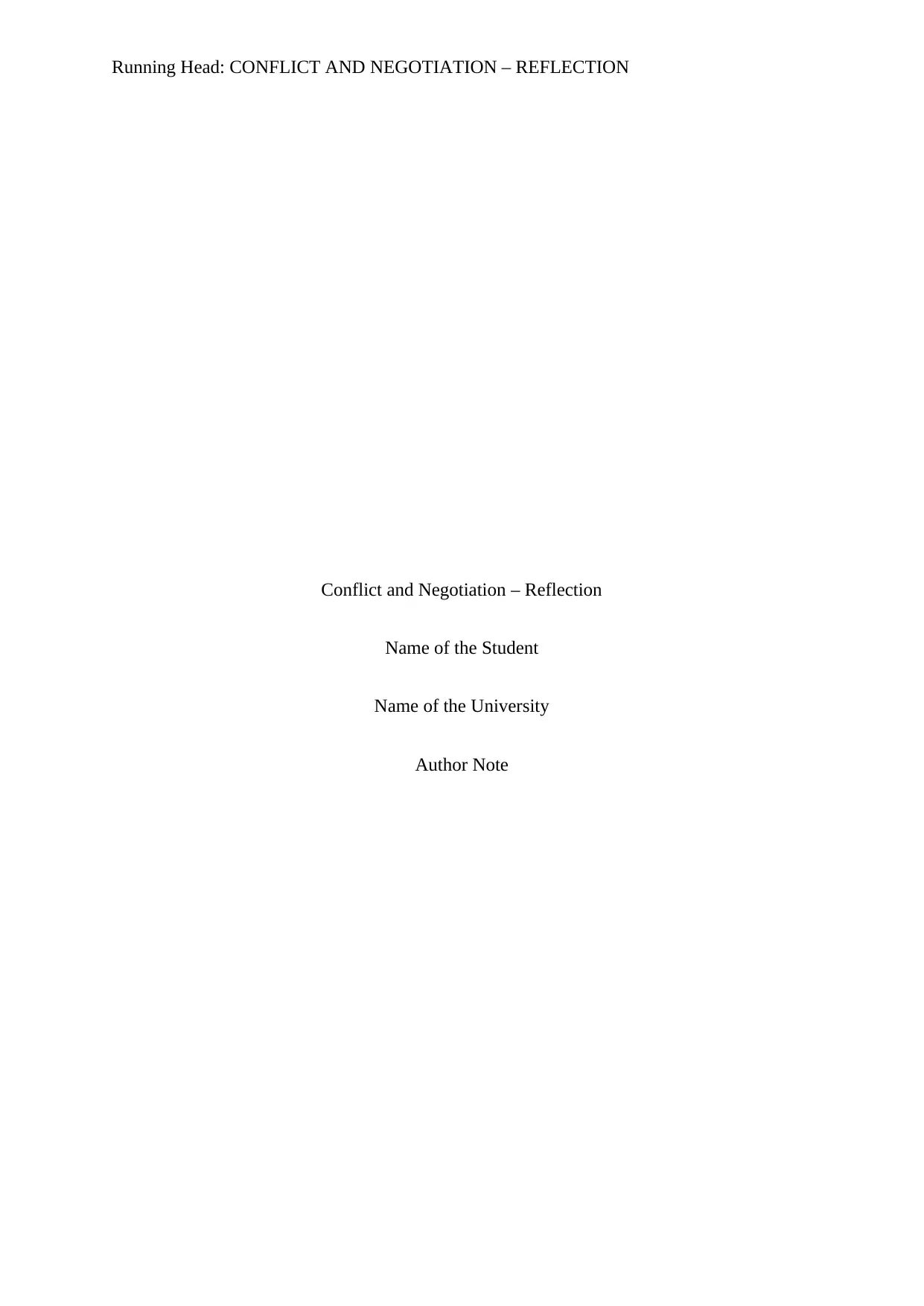
Running Head: CONFLICT AND NEGOTIATION – REFLECTION
Conflict and Negotiation – Reflection
Name of the Student
Name of the University
Author Note
Conflict and Negotiation – Reflection
Name of the Student
Name of the University
Author Note
Paraphrase This Document
Need a fresh take? Get an instant paraphrase of this document with our AI Paraphraser
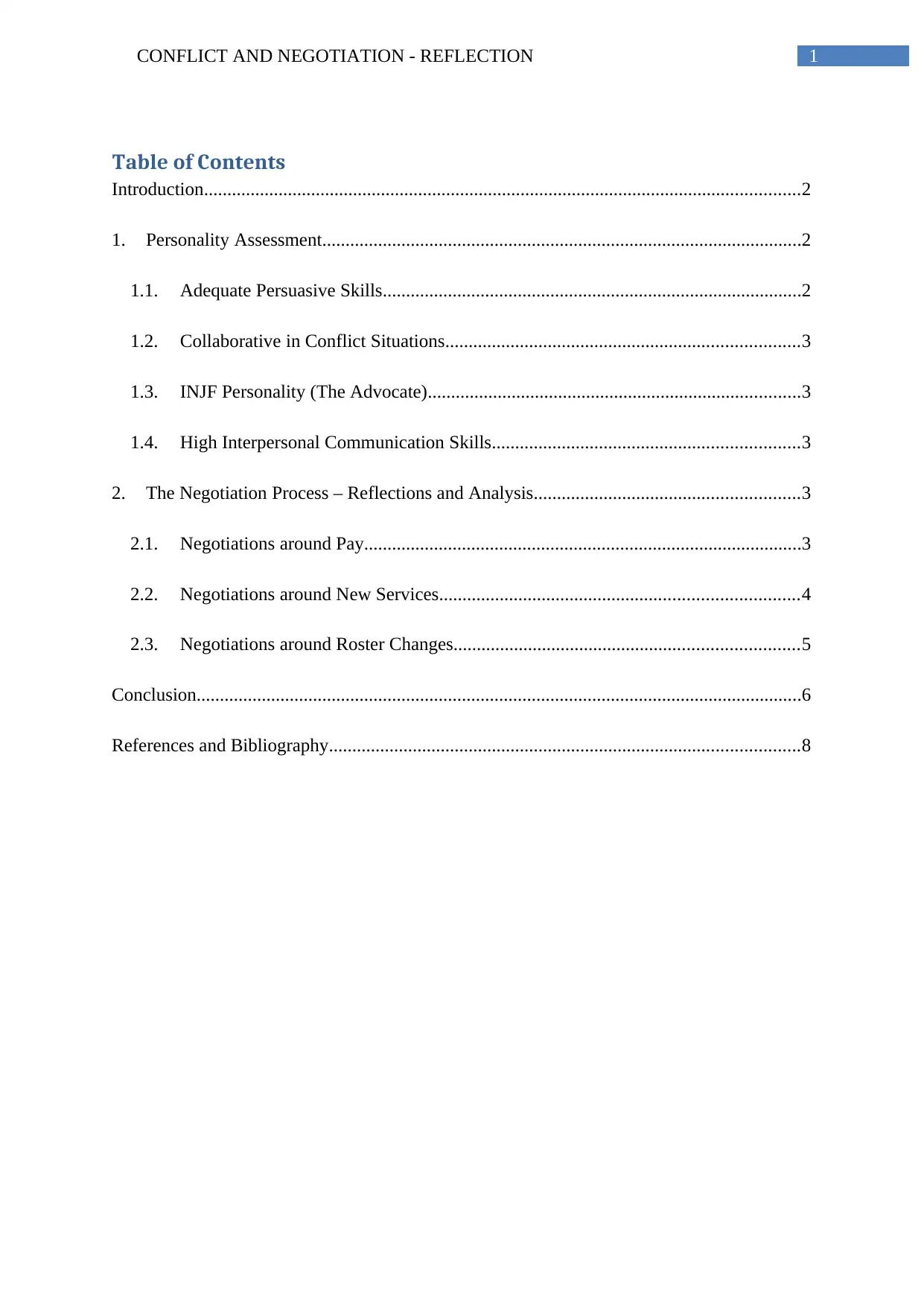
1CONFLICT AND NEGOTIATION - REFLECTION
Table of Contents
Introduction................................................................................................................................2
1. Personality Assessment.......................................................................................................2
1.1. Adequate Persuasive Skills..........................................................................................2
1.2. Collaborative in Conflict Situations............................................................................3
1.3. INJF Personality (The Advocate)................................................................................3
1.4. High Interpersonal Communication Skills..................................................................3
2. The Negotiation Process – Reflections and Analysis.........................................................3
2.1. Negotiations around Pay..............................................................................................3
2.2. Negotiations around New Services.............................................................................4
2.3. Negotiations around Roster Changes..........................................................................5
Conclusion..................................................................................................................................6
References and Bibliography.....................................................................................................8
Table of Contents
Introduction................................................................................................................................2
1. Personality Assessment.......................................................................................................2
1.1. Adequate Persuasive Skills..........................................................................................2
1.2. Collaborative in Conflict Situations............................................................................3
1.3. INJF Personality (The Advocate)................................................................................3
1.4. High Interpersonal Communication Skills..................................................................3
2. The Negotiation Process – Reflections and Analysis.........................................................3
2.1. Negotiations around Pay..............................................................................................3
2.2. Negotiations around New Services.............................................................................4
2.3. Negotiations around Roster Changes..........................................................................5
Conclusion..................................................................................................................................6
References and Bibliography.....................................................................................................8

2CONFLICT AND NEGOTIATION - REFLECTION
Introduction
Taking part in a negotiation activity on behalf of the Railway Workers Union is
something that I had to do for the very first time in my life, an experience that left me feeling
overwhelmed and happy with my power to negotiate a good deal. The Railway Workers
Union had recently taken up the cudgels of workers for the Suburban Railways because of the
fact that the company had imposed rigid working conditions. Such working conditions are
those that are characterized by a reduction in the number of hours needed to give a notice for
change in the roster from forty-eight hours to twenty-four hours, insufficient pay, and the
introduction of new services to ease customer commute during peak hours, something that
has left the railway workers feeling tired and exhausted beyond imagination. In this essay, I
shall present an analysis of what the negotiation process was like, and my key takeaways
from the entire process, with special emphasis on the lessons that I learnt in the bargain. Prior
to that, I give an overview of my personality assessment, as determined by four types of tests,
namely the persuasion test, interpersonal communication test, Thomas Kilmann Conflict
Style Questionnaire and MBIT Personality Test.
1. Personality Assessment
1.1. Adequate Persuasive Skills
I took a test to understand my skills at persuasion prior to embarking on the
negotiation process. According to the test results, my ability to be persuasive is adequate.
While I don’t readily agree to what another person is saying, I also listen attentively and get
my point across in a way that it is acknowledged if not agreed to by the other party.
Introduction
Taking part in a negotiation activity on behalf of the Railway Workers Union is
something that I had to do for the very first time in my life, an experience that left me feeling
overwhelmed and happy with my power to negotiate a good deal. The Railway Workers
Union had recently taken up the cudgels of workers for the Suburban Railways because of the
fact that the company had imposed rigid working conditions. Such working conditions are
those that are characterized by a reduction in the number of hours needed to give a notice for
change in the roster from forty-eight hours to twenty-four hours, insufficient pay, and the
introduction of new services to ease customer commute during peak hours, something that
has left the railway workers feeling tired and exhausted beyond imagination. In this essay, I
shall present an analysis of what the negotiation process was like, and my key takeaways
from the entire process, with special emphasis on the lessons that I learnt in the bargain. Prior
to that, I give an overview of my personality assessment, as determined by four types of tests,
namely the persuasion test, interpersonal communication test, Thomas Kilmann Conflict
Style Questionnaire and MBIT Personality Test.
1. Personality Assessment
1.1. Adequate Persuasive Skills
I took a test to understand my skills at persuasion prior to embarking on the
negotiation process. According to the test results, my ability to be persuasive is adequate.
While I don’t readily agree to what another person is saying, I also listen attentively and get
my point across in a way that it is acknowledged if not agreed to by the other party.
⊘ This is a preview!⊘
Do you want full access?
Subscribe today to unlock all pages.

Trusted by 1+ million students worldwide

3CONFLICT AND NEGOTIATION - REFLECTION
1.2. Collaborative in Conflict Situations
Based on the Thomas Kilmann Conflict Style Questionnaire, which I filled out before
the negotiation process, I got to know that I have a collaborative approach in conflict
situations. I try to work with the other party with whom there is conflict in a proactive fashion
to get concrete results that works for all.
1.3. INJF Personality (The Advocate)
According to the MBIT Personality Test which I also took before entering into
negotiations, I am an INJF Personality. This means that I am a person who is able to take
concrete steps to realize all of my goals in order to create a lasting impact in situations.
1.4. High Interpersonal Communication Skills
My ability to carry out inter personal communication is relatively strong, based on the
interpersonal communication skill test that I took. I can effectively communicate my needs
and requirements to the other party while apprehending and perceiving what it is that they
require or demand rather adequately.
2. The Negotiation Process – Reflections and Analysis
2.1. Negotiations around Pay
The first area of negotiation with the Suburban Railways was of course, centered
around the issue of pay. The railway workers are not getting half as much as what it is that
they deserve, and this is something that is reflecting in their performance as well. It is a fact
well known that any worker is likely to feel de-motivated and detached from the work that he
does if he is not paid as much as he should be. This is something that I noticed for the railway
workers as well, and so when I was given the opportunity to represent the issues of the
railway workers before the Suburban Railways, I made sure to mention the issue of pay right
1.2. Collaborative in Conflict Situations
Based on the Thomas Kilmann Conflict Style Questionnaire, which I filled out before
the negotiation process, I got to know that I have a collaborative approach in conflict
situations. I try to work with the other party with whom there is conflict in a proactive fashion
to get concrete results that works for all.
1.3. INJF Personality (The Advocate)
According to the MBIT Personality Test which I also took before entering into
negotiations, I am an INJF Personality. This means that I am a person who is able to take
concrete steps to realize all of my goals in order to create a lasting impact in situations.
1.4. High Interpersonal Communication Skills
My ability to carry out inter personal communication is relatively strong, based on the
interpersonal communication skill test that I took. I can effectively communicate my needs
and requirements to the other party while apprehending and perceiving what it is that they
require or demand rather adequately.
2. The Negotiation Process – Reflections and Analysis
2.1. Negotiations around Pay
The first area of negotiation with the Suburban Railways was of course, centered
around the issue of pay. The railway workers are not getting half as much as what it is that
they deserve, and this is something that is reflecting in their performance as well. It is a fact
well known that any worker is likely to feel de-motivated and detached from the work that he
does if he is not paid as much as he should be. This is something that I noticed for the railway
workers as well, and so when I was given the opportunity to represent the issues of the
railway workers before the Suburban Railways, I made sure to mention the issue of pay right
Paraphrase This Document
Need a fresh take? Get an instant paraphrase of this document with our AI Paraphraser
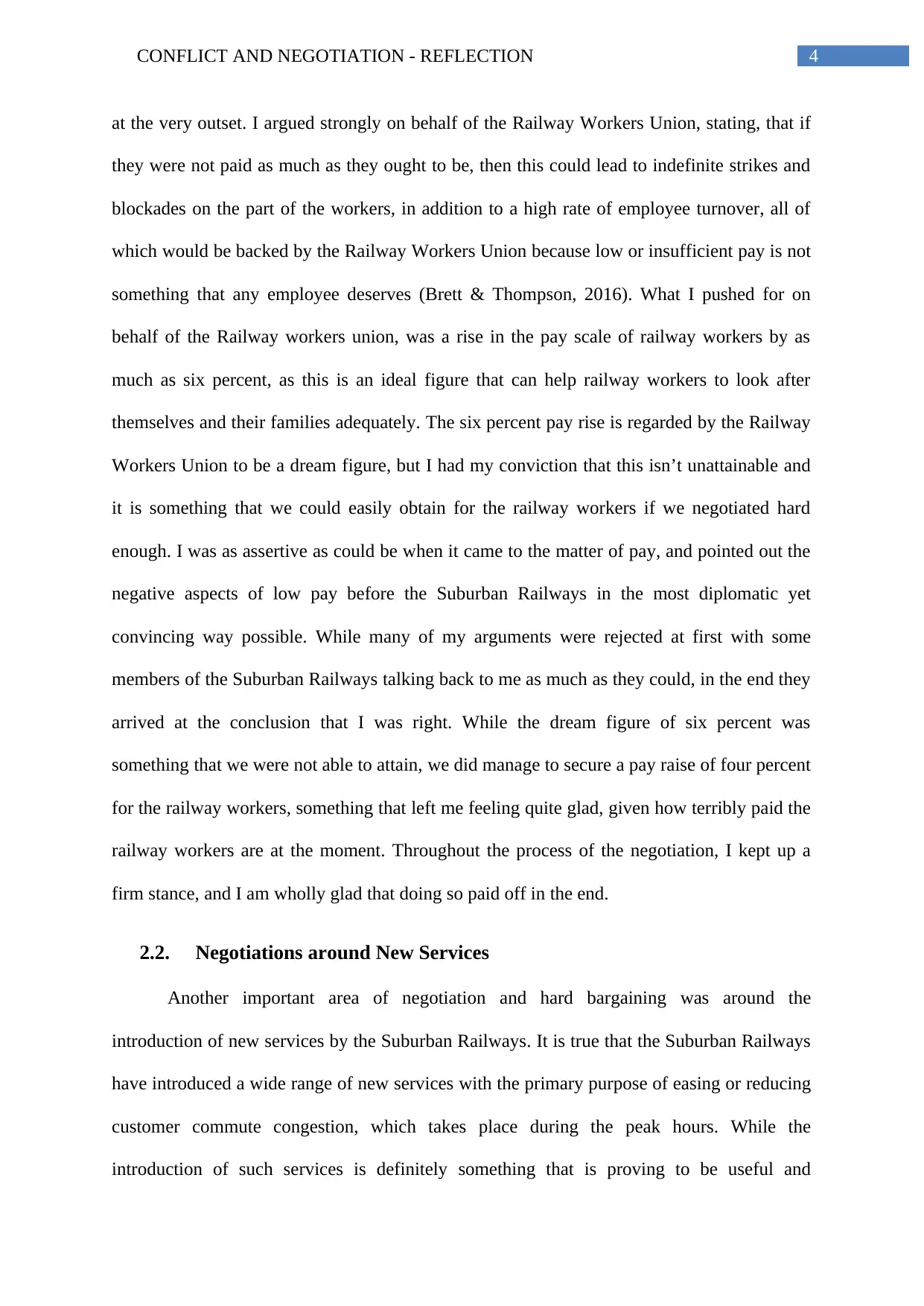
4CONFLICT AND NEGOTIATION - REFLECTION
at the very outset. I argued strongly on behalf of the Railway Workers Union, stating, that if
they were not paid as much as they ought to be, then this could lead to indefinite strikes and
blockades on the part of the workers, in addition to a high rate of employee turnover, all of
which would be backed by the Railway Workers Union because low or insufficient pay is not
something that any employee deserves (Brett & Thompson, 2016). What I pushed for on
behalf of the Railway workers union, was a rise in the pay scale of railway workers by as
much as six percent, as this is an ideal figure that can help railway workers to look after
themselves and their families adequately. The six percent pay rise is regarded by the Railway
Workers Union to be a dream figure, but I had my conviction that this isn’t unattainable and
it is something that we could easily obtain for the railway workers if we negotiated hard
enough. I was as assertive as could be when it came to the matter of pay, and pointed out the
negative aspects of low pay before the Suburban Railways in the most diplomatic yet
convincing way possible. While many of my arguments were rejected at first with some
members of the Suburban Railways talking back to me as much as they could, in the end they
arrived at the conclusion that I was right. While the dream figure of six percent was
something that we were not able to attain, we did manage to secure a pay raise of four percent
for the railway workers, something that left me feeling quite glad, given how terribly paid the
railway workers are at the moment. Throughout the process of the negotiation, I kept up a
firm stance, and I am wholly glad that doing so paid off in the end.
2.2. Negotiations around New Services
Another important area of negotiation and hard bargaining was around the
introduction of new services by the Suburban Railways. It is true that the Suburban Railways
have introduced a wide range of new services with the primary purpose of easing or reducing
customer commute congestion, which takes place during the peak hours. While the
introduction of such services is definitely something that is proving to be useful and
at the very outset. I argued strongly on behalf of the Railway Workers Union, stating, that if
they were not paid as much as they ought to be, then this could lead to indefinite strikes and
blockades on the part of the workers, in addition to a high rate of employee turnover, all of
which would be backed by the Railway Workers Union because low or insufficient pay is not
something that any employee deserves (Brett & Thompson, 2016). What I pushed for on
behalf of the Railway workers union, was a rise in the pay scale of railway workers by as
much as six percent, as this is an ideal figure that can help railway workers to look after
themselves and their families adequately. The six percent pay rise is regarded by the Railway
Workers Union to be a dream figure, but I had my conviction that this isn’t unattainable and
it is something that we could easily obtain for the railway workers if we negotiated hard
enough. I was as assertive as could be when it came to the matter of pay, and pointed out the
negative aspects of low pay before the Suburban Railways in the most diplomatic yet
convincing way possible. While many of my arguments were rejected at first with some
members of the Suburban Railways talking back to me as much as they could, in the end they
arrived at the conclusion that I was right. While the dream figure of six percent was
something that we were not able to attain, we did manage to secure a pay raise of four percent
for the railway workers, something that left me feeling quite glad, given how terribly paid the
railway workers are at the moment. Throughout the process of the negotiation, I kept up a
firm stance, and I am wholly glad that doing so paid off in the end.
2.2. Negotiations around New Services
Another important area of negotiation and hard bargaining was around the
introduction of new services by the Suburban Railways. It is true that the Suburban Railways
have introduced a wide range of new services with the primary purpose of easing or reducing
customer commute congestion, which takes place during the peak hours. While the
introduction of such services is definitely something that is proving to be useful and
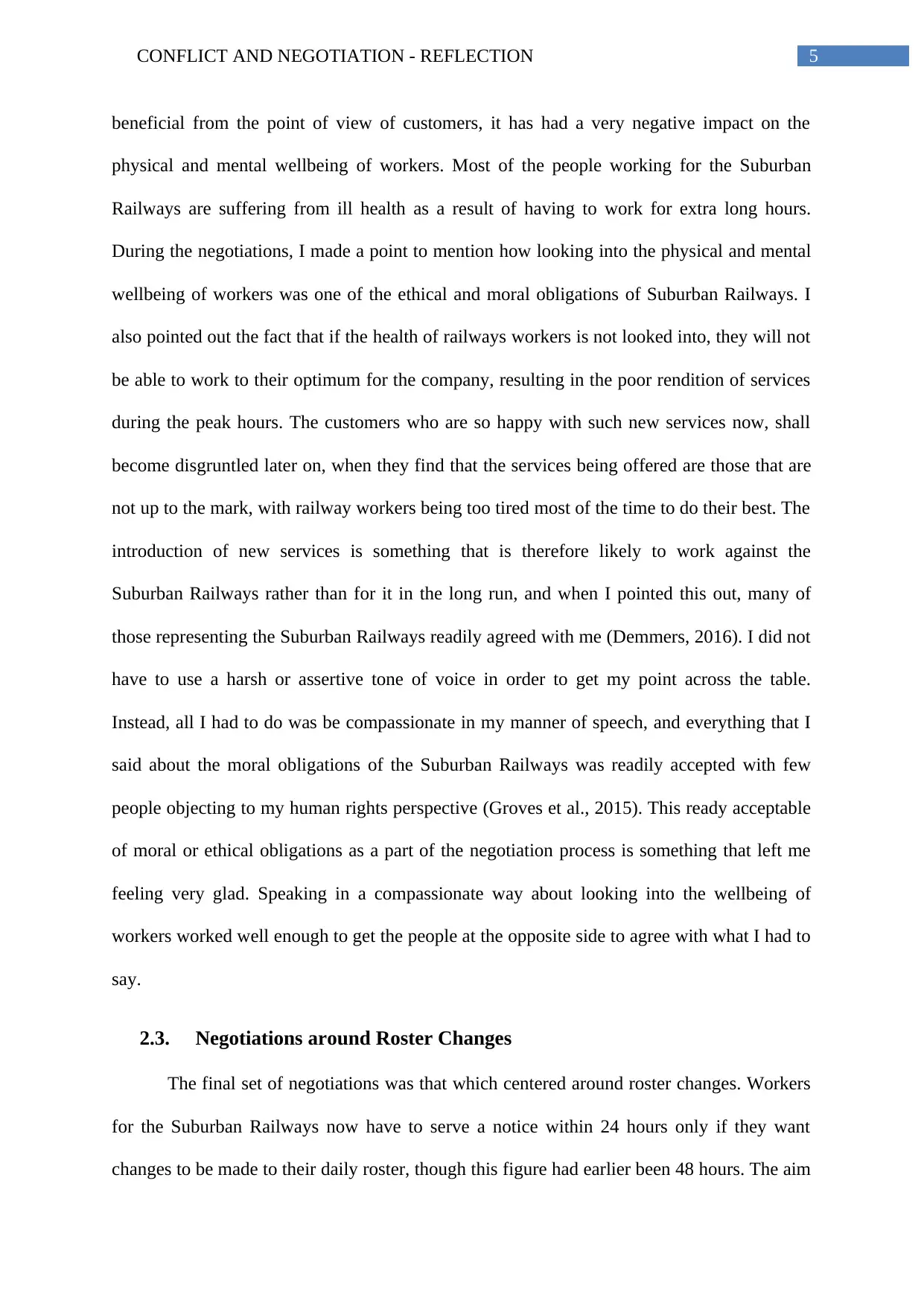
5CONFLICT AND NEGOTIATION - REFLECTION
beneficial from the point of view of customers, it has had a very negative impact on the
physical and mental wellbeing of workers. Most of the people working for the Suburban
Railways are suffering from ill health as a result of having to work for extra long hours.
During the negotiations, I made a point to mention how looking into the physical and mental
wellbeing of workers was one of the ethical and moral obligations of Suburban Railways. I
also pointed out the fact that if the health of railways workers is not looked into, they will not
be able to work to their optimum for the company, resulting in the poor rendition of services
during the peak hours. The customers who are so happy with such new services now, shall
become disgruntled later on, when they find that the services being offered are those that are
not up to the mark, with railway workers being too tired most of the time to do their best. The
introduction of new services is something that is therefore likely to work against the
Suburban Railways rather than for it in the long run, and when I pointed this out, many of
those representing the Suburban Railways readily agreed with me (Demmers, 2016). I did not
have to use a harsh or assertive tone of voice in order to get my point across the table.
Instead, all I had to do was be compassionate in my manner of speech, and everything that I
said about the moral obligations of the Suburban Railways was readily accepted with few
people objecting to my human rights perspective (Groves et al., 2015). This ready acceptable
of moral or ethical obligations as a part of the negotiation process is something that left me
feeling very glad. Speaking in a compassionate way about looking into the wellbeing of
workers worked well enough to get the people at the opposite side to agree with what I had to
say.
2.3. Negotiations around Roster Changes
The final set of negotiations was that which centered around roster changes. Workers
for the Suburban Railways now have to serve a notice within 24 hours only if they want
changes to be made to their daily roster, though this figure had earlier been 48 hours. The aim
beneficial from the point of view of customers, it has had a very negative impact on the
physical and mental wellbeing of workers. Most of the people working for the Suburban
Railways are suffering from ill health as a result of having to work for extra long hours.
During the negotiations, I made a point to mention how looking into the physical and mental
wellbeing of workers was one of the ethical and moral obligations of Suburban Railways. I
also pointed out the fact that if the health of railways workers is not looked into, they will not
be able to work to their optimum for the company, resulting in the poor rendition of services
during the peak hours. The customers who are so happy with such new services now, shall
become disgruntled later on, when they find that the services being offered are those that are
not up to the mark, with railway workers being too tired most of the time to do their best. The
introduction of new services is something that is therefore likely to work against the
Suburban Railways rather than for it in the long run, and when I pointed this out, many of
those representing the Suburban Railways readily agreed with me (Demmers, 2016). I did not
have to use a harsh or assertive tone of voice in order to get my point across the table.
Instead, all I had to do was be compassionate in my manner of speech, and everything that I
said about the moral obligations of the Suburban Railways was readily accepted with few
people objecting to my human rights perspective (Groves et al., 2015). This ready acceptable
of moral or ethical obligations as a part of the negotiation process is something that left me
feeling very glad. Speaking in a compassionate way about looking into the wellbeing of
workers worked well enough to get the people at the opposite side to agree with what I had to
say.
2.3. Negotiations around Roster Changes
The final set of negotiations was that which centered around roster changes. Workers
for the Suburban Railways now have to serve a notice within 24 hours only if they want
changes to be made to their daily roster, though this figure had earlier been 48 hours. The aim
⊘ This is a preview!⊘
Do you want full access?
Subscribe today to unlock all pages.

Trusted by 1+ million students worldwide
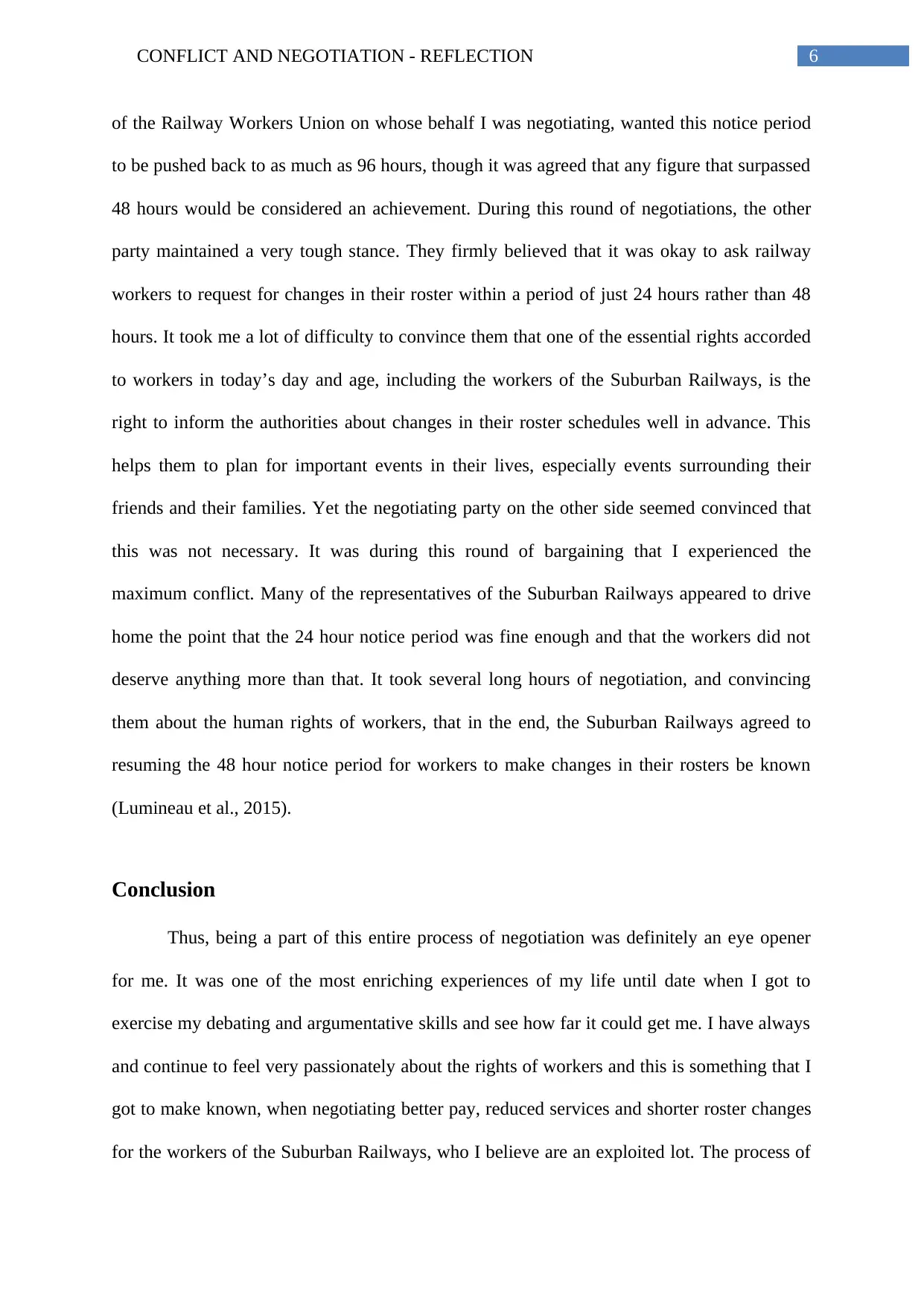
6CONFLICT AND NEGOTIATION - REFLECTION
of the Railway Workers Union on whose behalf I was negotiating, wanted this notice period
to be pushed back to as much as 96 hours, though it was agreed that any figure that surpassed
48 hours would be considered an achievement. During this round of negotiations, the other
party maintained a very tough stance. They firmly believed that it was okay to ask railway
workers to request for changes in their roster within a period of just 24 hours rather than 48
hours. It took me a lot of difficulty to convince them that one of the essential rights accorded
to workers in today’s day and age, including the workers of the Suburban Railways, is the
right to inform the authorities about changes in their roster schedules well in advance. This
helps them to plan for important events in their lives, especially events surrounding their
friends and their families. Yet the negotiating party on the other side seemed convinced that
this was not necessary. It was during this round of bargaining that I experienced the
maximum conflict. Many of the representatives of the Suburban Railways appeared to drive
home the point that the 24 hour notice period was fine enough and that the workers did not
deserve anything more than that. It took several long hours of negotiation, and convincing
them about the human rights of workers, that in the end, the Suburban Railways agreed to
resuming the 48 hour notice period for workers to make changes in their rosters be known
(Lumineau et al., 2015).
Conclusion
Thus, being a part of this entire process of negotiation was definitely an eye opener
for me. It was one of the most enriching experiences of my life until date when I got to
exercise my debating and argumentative skills and see how far it could get me. I have always
and continue to feel very passionately about the rights of workers and this is something that I
got to make known, when negotiating better pay, reduced services and shorter roster changes
for the workers of the Suburban Railways, who I believe are an exploited lot. The process of
of the Railway Workers Union on whose behalf I was negotiating, wanted this notice period
to be pushed back to as much as 96 hours, though it was agreed that any figure that surpassed
48 hours would be considered an achievement. During this round of negotiations, the other
party maintained a very tough stance. They firmly believed that it was okay to ask railway
workers to request for changes in their roster within a period of just 24 hours rather than 48
hours. It took me a lot of difficulty to convince them that one of the essential rights accorded
to workers in today’s day and age, including the workers of the Suburban Railways, is the
right to inform the authorities about changes in their roster schedules well in advance. This
helps them to plan for important events in their lives, especially events surrounding their
friends and their families. Yet the negotiating party on the other side seemed convinced that
this was not necessary. It was during this round of bargaining that I experienced the
maximum conflict. Many of the representatives of the Suburban Railways appeared to drive
home the point that the 24 hour notice period was fine enough and that the workers did not
deserve anything more than that. It took several long hours of negotiation, and convincing
them about the human rights of workers, that in the end, the Suburban Railways agreed to
resuming the 48 hour notice period for workers to make changes in their rosters be known
(Lumineau et al., 2015).
Conclusion
Thus, being a part of this entire process of negotiation was definitely an eye opener
for me. It was one of the most enriching experiences of my life until date when I got to
exercise my debating and argumentative skills and see how far it could get me. I have always
and continue to feel very passionately about the rights of workers and this is something that I
got to make known, when negotiating better pay, reduced services and shorter roster changes
for the workers of the Suburban Railways, who I believe are an exploited lot. The process of
Paraphrase This Document
Need a fresh take? Get an instant paraphrase of this document with our AI Paraphraser

7CONFLICT AND NEGOTIATION - REFLECTION
conflict and negotiation is an age old one, and those engaging in negotiation activities in a
conflict situation need to exercise a lot of tact and restraint in order to get their points across
as effectively as possible. I have realized in the process of these across the table negotiations,
that plenty of patience, cool headedness and firmness of belief need to come into play, if
arguments are to be made in favor of a party and to get these arguments accepted by the other
party is one of the most rewarding experiences one could ever ask for.
conflict and negotiation is an age old one, and those engaging in negotiation activities in a
conflict situation need to exercise a lot of tact and restraint in order to get their points across
as effectively as possible. I have realized in the process of these across the table negotiations,
that plenty of patience, cool headedness and firmness of belief need to come into play, if
arguments are to be made in favor of a party and to get these arguments accepted by the other
party is one of the most rewarding experiences one could ever ask for.
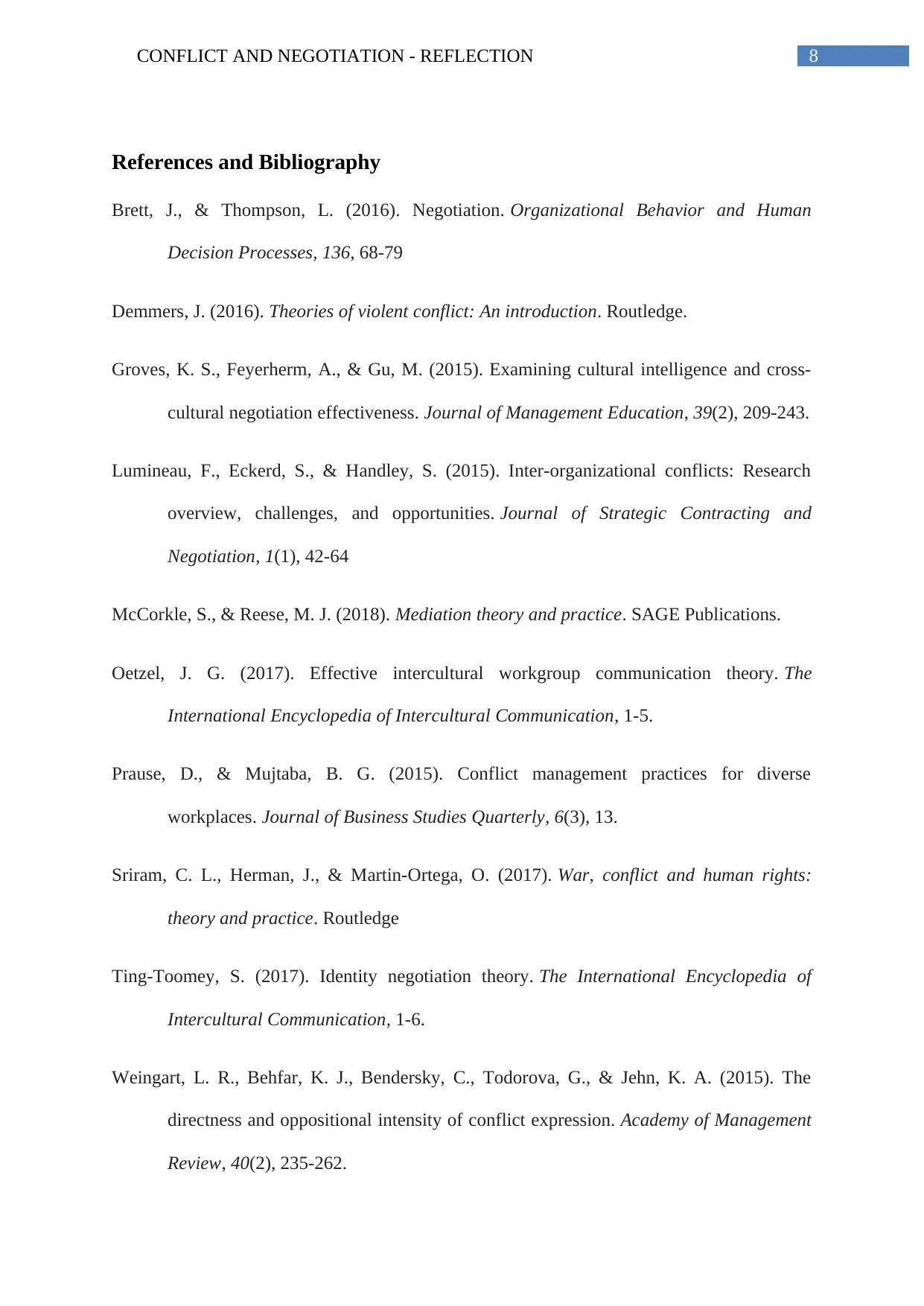
8CONFLICT AND NEGOTIATION - REFLECTION
References and Bibliography
Brett, J., & Thompson, L. (2016). Negotiation. Organizational Behavior and Human
Decision Processes, 136, 68-79
Demmers, J. (2016). Theories of violent conflict: An introduction. Routledge.
Groves, K. S., Feyerherm, A., & Gu, M. (2015). Examining cultural intelligence and cross-
cultural negotiation effectiveness. Journal of Management Education, 39(2), 209-243.
Lumineau, F., Eckerd, S., & Handley, S. (2015). Inter-organizational conflicts: Research
overview, challenges, and opportunities. Journal of Strategic Contracting and
Negotiation, 1(1), 42-64
McCorkle, S., & Reese, M. J. (2018). Mediation theory and practice. SAGE Publications.
Oetzel, J. G. (2017). Effective intercultural workgroup communication theory. The
International Encyclopedia of Intercultural Communication, 1-5.
Prause, D., & Mujtaba, B. G. (2015). Conflict management practices for diverse
workplaces. Journal of Business Studies Quarterly, 6(3), 13.
Sriram, C. L., Herman, J., & Martin-Ortega, O. (2017). War, conflict and human rights:
theory and practice. Routledge
Ting‐Toomey, S. (2017). Identity negotiation theory. The International Encyclopedia of
Intercultural Communication, 1-6.
Weingart, L. R., Behfar, K. J., Bendersky, C., Todorova, G., & Jehn, K. A. (2015). The
directness and oppositional intensity of conflict expression. Academy of Management
Review, 40(2), 235-262.
References and Bibliography
Brett, J., & Thompson, L. (2016). Negotiation. Organizational Behavior and Human
Decision Processes, 136, 68-79
Demmers, J. (2016). Theories of violent conflict: An introduction. Routledge.
Groves, K. S., Feyerherm, A., & Gu, M. (2015). Examining cultural intelligence and cross-
cultural negotiation effectiveness. Journal of Management Education, 39(2), 209-243.
Lumineau, F., Eckerd, S., & Handley, S. (2015). Inter-organizational conflicts: Research
overview, challenges, and opportunities. Journal of Strategic Contracting and
Negotiation, 1(1), 42-64
McCorkle, S., & Reese, M. J. (2018). Mediation theory and practice. SAGE Publications.
Oetzel, J. G. (2017). Effective intercultural workgroup communication theory. The
International Encyclopedia of Intercultural Communication, 1-5.
Prause, D., & Mujtaba, B. G. (2015). Conflict management practices for diverse
workplaces. Journal of Business Studies Quarterly, 6(3), 13.
Sriram, C. L., Herman, J., & Martin-Ortega, O. (2017). War, conflict and human rights:
theory and practice. Routledge
Ting‐Toomey, S. (2017). Identity negotiation theory. The International Encyclopedia of
Intercultural Communication, 1-6.
Weingart, L. R., Behfar, K. J., Bendersky, C., Todorova, G., & Jehn, K. A. (2015). The
directness and oppositional intensity of conflict expression. Academy of Management
Review, 40(2), 235-262.
⊘ This is a preview!⊘
Do you want full access?
Subscribe today to unlock all pages.

Trusted by 1+ million students worldwide
1 out of 9
Your All-in-One AI-Powered Toolkit for Academic Success.
+13062052269
info@desklib.com
Available 24*7 on WhatsApp / Email
![[object Object]](/_next/static/media/star-bottom.7253800d.svg)
Unlock your academic potential
Copyright © 2020–2025 A2Z Services. All Rights Reserved. Developed and managed by ZUCOL.
